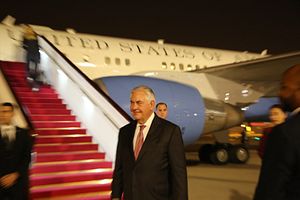U.S. Secretary of State Rex Tillerson is in China this weekend for a visit to lay the groundwork for U.S. President Donald Trump’s upcoming state visit to Beijing in November.
Speaking to reporters before meetings with senior Chinese officials, including President Xi Jinping, Tillerson acknowledged that the United States had three separate direct and open channels of communication with North Korea.
“We have a couple, three channels open to Pyongyang. We can talk to them, we do talk to them,” Tillerson told reporters in Beijing, according to a pool report.
“We ask, ‘Would you like to talk?’ We have lines of communications to Pyongyang — we’re not in a dark situation, a blackout,” Tillerson added.
He clarified that these were direct channels that were not being mediated by any way by China, North Korea’s most important trading partner and benefactor.
Tillerson did not offer any assessment of if these channels were demonstrating results.
“The whole situation is a bit overheated right now,” he said. “I think everyone would like for it to calm down. I think if North Korea would stop firing all the missiles, that would calm down things a lot.”
North Korea has continued to fire ballistic missiles throughout the year, introducing more advanced missiles and more provocative tests as the year has gone on.
It has tested its new Hwasong-14 intercontinental-range ballistic missile twice, in July, and overflown Japan twice with its Hwasong-12 intermediate-range ballistic missile. In early September, North Korea carried out its sixth and most powerful nuclear test.
The existence of open channels between the United States and North Korea is not entirely surprising, but the specific number—three—is somewhat curious.
The so-called ‘New York channel’ between the two countries is thought to be the most important remaining bilateral channel.
That channel allowed, for example, Joseph Yun, the United States Special Representative for North Korea Policy, to secure the release of Otto Warmbier, a detained American college student, earlier this year. Warmbier returned from North Korea in a comatose state and died shortly after returning to the United States.
It’s unclear what other channels Tillerson was referring to. One possibility is that he was including ongoing so-called Track 1.5 engagements between the two sides, where North Korean government representatives meet with private U.S. citizens with either a background in North Korea policy-making or relevant expertise.
The U.S. government takes an interest in the content of those talks, even if it does not directly participate.
Tillerson’s acknowledgement of multiple direct channels between the two sides nevertheless comes after a new war of words sparked by Trump’s address to the United Nations General Assembly, where he threatened to “totally destroy” North Korea if the United States had to defend itself or its allies from an attack.
In response, North Korean leader Kim Jong-un released a statement calling Trump a “barking dog” and threatening to “tame” him with further provocations.

































